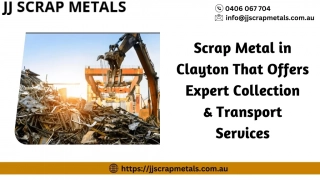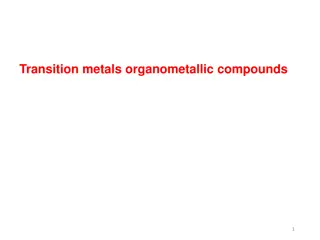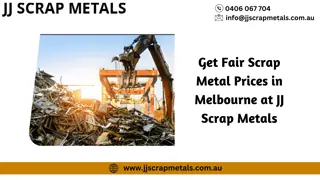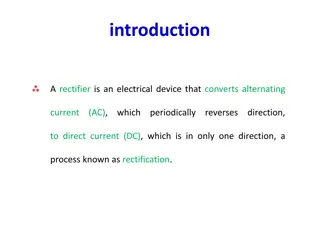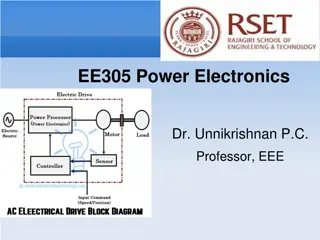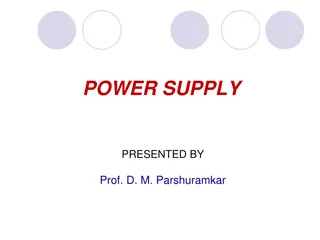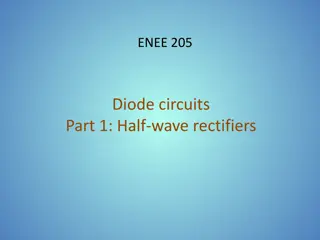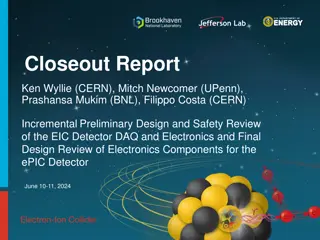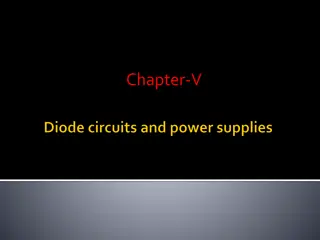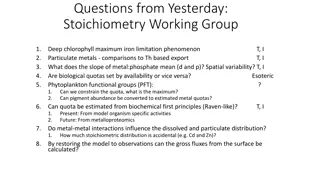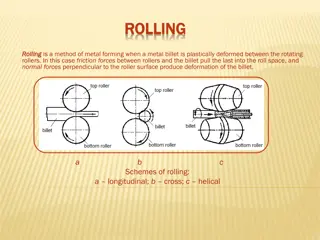Metal Rectifiers in Electronics
Metal rectifiers, such as copper oxide or selenium, are early semiconductor devices used for rectifying current in radios and battery chargers. Learn about their construction, efficiency, and applications compared to modern silicon diodes. Discover the principles of operation and differences between selenium and copper oxide rectifiers.
Download Presentation

Please find below an Image/Link to download the presentation.
The content on the website is provided AS IS for your information and personal use only. It may not be sold, licensed, or shared on other websites without obtaining consent from the author.If you encounter any issues during the download, it is possible that the publisher has removed the file from their server.
You are allowed to download the files provided on this website for personal or commercial use, subject to the condition that they are used lawfully. All files are the property of their respective owners.
The content on the website is provided AS IS for your information and personal use only. It may not be sold, licensed, or shared on other websites without obtaining consent from the author.
E N D
Presentation Transcript
RECTIFIER AND TRANSFORMER Dr Kapil Garg Dept. Of Musculoskeletal Physiotherapy MGM Institute Of Physiotherapy Chh. Sambhajinagar
Metal rectifier A metal rectifier is an early type semiconductor is copper oxide or selenium. of semiconductor rectifier in which the They current to direct current in devices such as radios and battery chargers. were used in power applications to convert alternating
Metal either or steel or aluminium, plated with selenium. rectifiers copper consist (with of oxide washer-like layer discs provide of different the metals, an to rectification) The discs are often separated by spacer sleeves to provide cooling.
The principle of operation of a metal rectifier modern semiconductor rectifiers, but somewhat Both selenium and copper oxide are semiconductors, in practice doped by impurities manufacture. When deposited on metals, it would be expected that the result is a simple metal semiconductor junction and that the rectification would be a result of a Schottky barrier. is related to more complex. during are they
Selenium rectifiers were generally more efficient than metal-oxide types, and could handle higher voltages. However, considerably more skill was required for their construction. Selenium rectifiers were once widely used as high-tension rectifiers in transformer less radio and TV sets, before cheaper silicon diodes became available.
Although they were reasonably efficient in this application, (at least compared to vacuum-tube rectifiers), their internal resistance tended to increase as they aged. Apart from reducing the available high voltage, this tends to make them run hotter, producing an unpleasant smell as the selenium starts to evaporate.
Different types of rectification The conversion of alternating current into the direct current is called rectification. Semiconductor diodes are extensively used for this purpose.
1. Half Wave Rectification An alternating voltage of Time period T is called input voltage is applied to a diode D which is connected in series with a load resistance R. In this method only one half of alternating current cycle is converted into direct current. During the positive half cycle of the input alternating voltage during the time interval 0 T/2, the diode D is forward biased, so it offers very low resistance and current flows through R. The flow of current through R causes a potential drop across it which varies in accordance with the alternating input.
During the negative half cycle of the input alternating voltage during the time interval T/2 T, the diode D is reverse biased, so it offers very high resistance and practically no current flows through R and the potential drop across R is almost zero. The same events repeat during the next cycle and so on. The current through R flows in only one direction which means it is a direct current. However this current flows in pulses. The voltage which appears across load resistance R is known as output voltage.
2. Full Wave Rectification The circuit consists of two diodes and a center tap transformer. When the center tap is grounded the voltage at opposite ends of the secondary coil is 180 out of phase with each other. During the positive half cycle at point 1, there is a negative half cycle at point 2. Therefore diode D1is forward biased and allows the current to flow through the junction while diode D2is reverse biased and acts as an open circuit. As a result, the positive half cycle appears across the output
During the negative half-cycle at point 1, there is a positive half cycle at point 2. Therefore diode D1biased and stops conducting, while diode D2 is forward biased and conducts, hence we get another positive half cycle across the output, through D2. Thus during these half of A.C. input, the current flows in the same direction through the load resistance. The output voltage across the load resistance is rippled DC containing both the half cycles. To get smooth DC a suitable capacitor is connected in parallel with the resistance R.
3. Full Wave Bridge Rectification We have seen that in a half-wave rectification, we get the output by only one half of the alternating output voltage. The other half cycle is blocked and we get no output. However, both halves of the output voltage cycle can be utilized using full-wave rectification. Its circuit consists of four diodes connected in such a way to form a bridge.
Transformer A transformer is a passive component that transfers electrical energy from one electrical circuit to another circuit, or multiple circuits. A varying current in any one coil of the transformer produces a varying magnetic flux in the transformer's core, which induces a varying electromotive force across any other coils wound around the same core.
Transformers are most commonly used for increasing low AC voltages at high current (a step-up transformer) or decreasing high AC voltages at low current (a step-down transformer) in electric power applications, and for coupling the stages of signal-processing circuits. A wide range of transformer designs is encountered in electronic and electric power applications. Transformers range in size from RF transformers less than a cubic centimetre in volume, to units weighing hundreds of tons used to interconnect the power grid.
Transformer is not an energy conversion device, but it is device that changes AC electrical power at one voltage level into AC electrical power at another voltage level through the action of magnetic field. It can be either to step-up or step down.
Working Of Transformer The main principle of operation of a transformer is mutual inductance between two circuits which is linked by a common magnetic flux. A basic transformer consists of two coils that are electrically separate and inductive, but are magnetically linked through a path of reluctance.
Working Principal The changing current in the primary coil, is usually achieved by applying an alternating voltage, resulting in an alternating current (AC) AC input. As the alternating current changes magnitude and direction, a magnetic field is produced, which changes in a corresponding manner C-CUBE Group of Engineers.
The field from the primary coil is intensified and concentrated through the secondary coil by an iron core AC output. The changing flux through the secondary coil, induces a potential difference across the secondary coil.
Classification of Transformer As per phase Single phase Three phase As per core Core type Shell type As per cooling system Self-cooled Air cooled Oil cooled
Single Phase Transformer A single-phase transformer can operate to either increase or decrease the voltage applied to the primary winding. Two or more winding, coupled by a common magnetic core. It is called a Step up transformer
Three Phase Transformer A single enclosure with three primary and three secondary windings wound on a common core is all that is required. Since each single-phase transformer has a primary and a secondary winding, then 3 single-phase transformers will have the required 3 primary and 3 secondary windings.
Ideal Transformer An ideal transformer is a transformer which has no loses, i.e. it s winding has no ohmic resistance, no magnetic leakage, and therefore no R and core loses. Ideal transformer will be used in characterized the practical transformer.
Core Type Transformer The windings are given to a considerable part of the core. The coils used for this transformer are form-wound and are of cylindrical type. The general arrangement of the core- type transformer with respect to the core.
Shell-Type Transformer In shell-type transformers the core surrounds a considerable portion of the windings. The coils are form-wound but are multi layer disc type usually wound in the form of pancakes. The whole winding consists of discs stacked with insulation spaces between the coils.
Oil Filled Self-Cooled Type Oil filled self cooled type uses small and medium-sized distribution transformers. The assembled windings and core of such transformers are mounted in a welded, oil- tight steel tanks provided with a steel cover. The oil helps in transferring the heat from the core and the windings to the case from where it is radiated out to the surroundings
Oil Filled Water Cooled Type This type is used for much more economic construction of large transformers. The method is used here as well- the windings and the core are immersed in the oil. The only difference is that a cooling coil is mounted near the surface of the oil, through which cold water keeps circulating. This water carries the heat from the device. This design is usually implemented on transformers that are used in high voltage transmission lines.
Air Blast Type This type is used for transformers that use voltages below 25,000 volts.. The transformer is housed in a thin sheet metal box open at both ends through which air is blown from the bottom to the top.
Advantages Copper required is very less. High efficient than two winding transformer. Small size and low cost. Resistance and leakage reactance is less compared to two winding transformer. Copper losses are less. Superior transformer. voltages regulation than two winding
Disadvantages Low impedance hence high short circuit currents for short circuits on secondary side. If a section of winding common to primary and secondary is opened , full primary voltage appears across the secondary resulting in higher voltage on secondary and danger of accidents. No electrical separation between primary and secondary which is risky in case of high voltage levels.

 undefined
undefined




